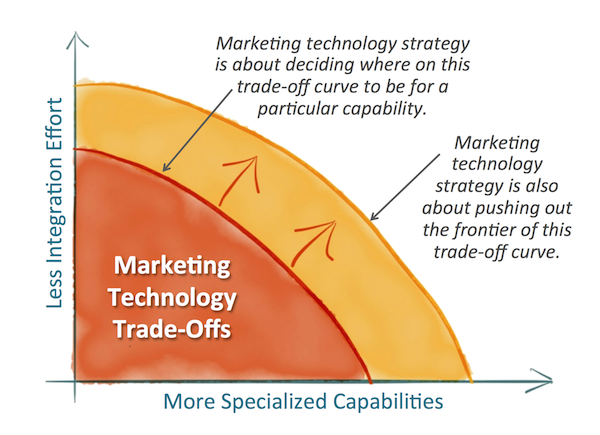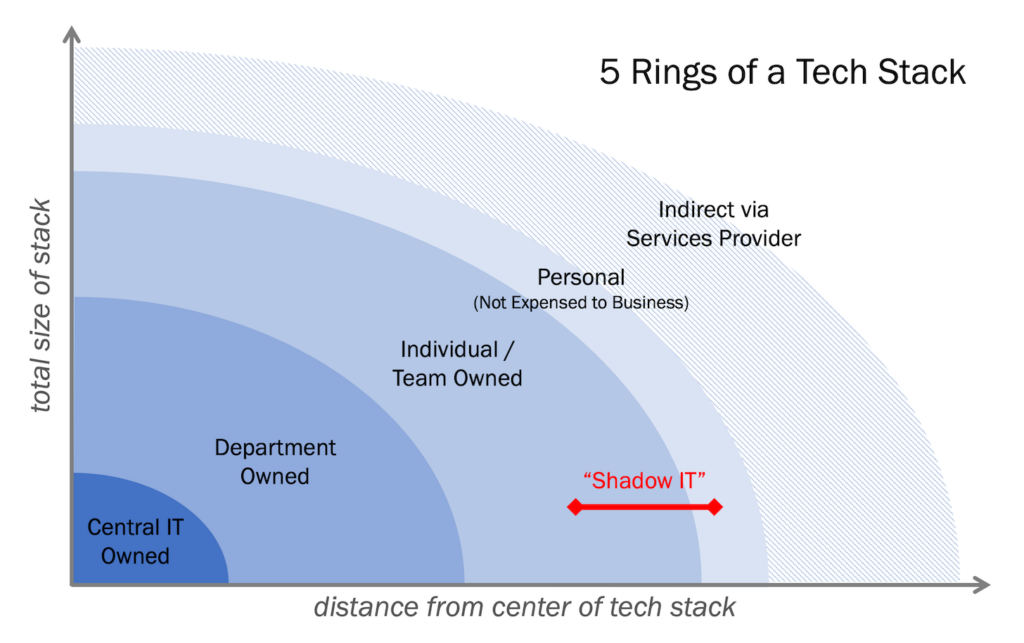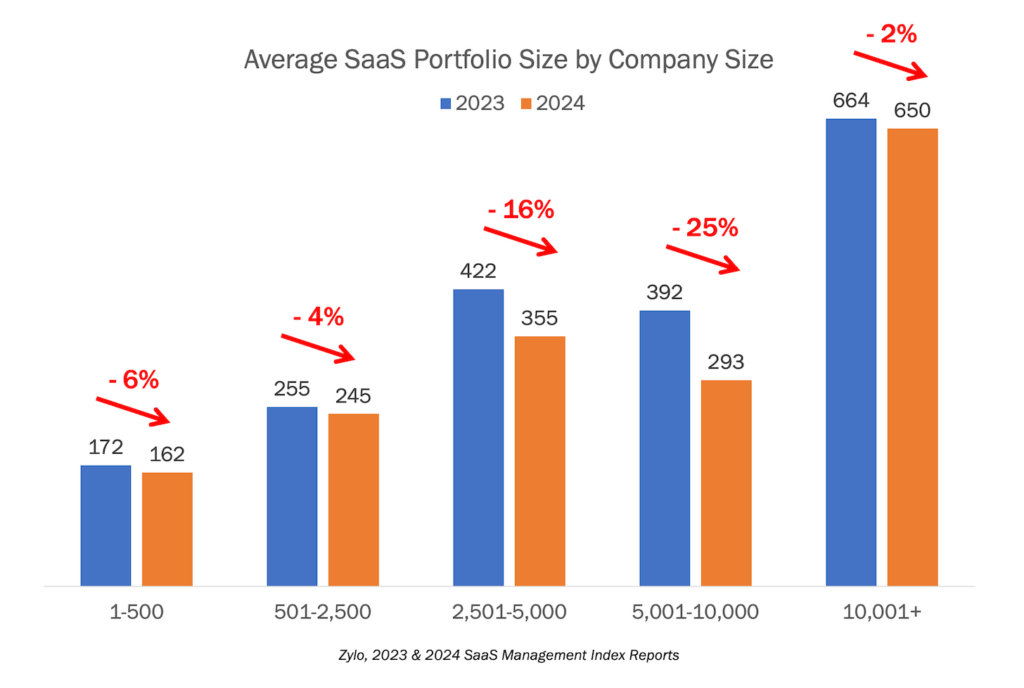There is a myth that implementing a marketing technology point solution is a bad idea. Like giving your significant other a bathroom scale as a birthday present is a bad idea. First aid kit sold separately.
But it is a myth. (The bathroom scale is still a bad idea though.)
I’ll explain what a point solution is, why they’re considered bad, and why that’s bunk. I’ll discuss what the real problem is with point solutions — it has little to do with the point solution itself and everything to do with how it fits (or not) into your larger marketing management picture. I’ll even argue that if you’re not using at least a few point solutions in your marketing ecosystem, you’re almost certainly missing big opportunities.
But first, let me make the mother of all disclosures.
I’m the co-founder and CTO of a company that sells a marketing technology point solution. We make a software-as-a-service product that lets marketers create and optimize amazing post-click experiences. So I’m patently biased, and I have an obvious incentive to convince you that point solutions are good for you, the new Vitamin P.
So by all means, put on your skeptic’s hat, question my motives, and decide if my rationale makes sense in spite of my bias.
What’s the point and why does it need to be solved?
What exactly is a point solution?
The simple answer is that a point solution is a product or service that addresses one very specific need in a marketing organization. It specializes in solving that one particular problem really, really well. It doesn’t try to boil the ocean. It boils one pot on the stove.
Point solutions are in contrast to larger, conglomerate solutions — often called suites or platforms or “clouds” (the newest label du jour) — that aim to address many different marketing needs with a single product, product portfolio, or service.
I know, that’s a little cloudy (pun intended). It helps if we consider specific examples.
Products like Google Analytics, Sprinklr, IfByPhone, WordStream, ClickTale, Lattice Engines, Widen, Demandbase, Pixability, MailChimp, and my own company, ion interactive, are point solutions. Products like Adobe Marketing Cloud, Salesforce Marketing Cloud, Marketo, Oracle/Eloqua, HubSpot, SDL, SAS Customer Intelligence, and IBM Enterprise Marketing Management are examples of conglomerate solutions.
You can often identify conglomerate solutions by the fact that they have been assembled from multiple acquisitions, bringing previously disparate products into their fold.
Another way of visualizing point solutions is with Gartner’s digital marketing transit map — almost all of the “stations” on this map are, at least theoretically, point solutions. In contrast, conglomerate solutions combine multiple stations under the umbrella of a single offering (or at least a single brand).
In truth, however, it’s not black and white. There is a wide band of gray where something can be considered more of a point solution or more of a conglomerate. Many vendors incorporate more than one of those stations into their product or portfolio. For instance, my company’s point solution mixes content management, A/B testing, and customer analytics.
The line between point solution and conglomerate solution may also vary by the way marketers use them. For instance, it’s not unusual for a marketing team to have Marketo, Salesforce, and Adobe products all within their organization, each addressing specific needs.
In other words, one marketer’s conglomerate solution may be another marketer’s point solution. Unless you have one mega-lithic software package running your entire business — and companies like Oracle and SAP may be aiming for just that — even a whole marketing technology suite might be considered a point solution in the eyes of a corporate CIO.
But without getting tangled up in semantics, let’s say that a point solution has a narrower focus while a conglomerate solution has a broader reach.
Why are point solutions (falsely) considered a bad idea?
There are generally two reasons why point solutions get a bad rap:
- They may require integration work to connect with your other software.
- They may be used myopically without regard for the bigger marketing picture.
Now, the first is a legitimate factor. Not all point solutions require integration, but many do. For instance, my company’s software collects leads that are almost always forwarded on to a marketing automation or CRM platform. That requires integration between the two software packages.
Luckily, many of those integrations are getting easier and easier — for reasons we’ll discuss shortly. But there’s still some effort required to establish and maintain that integration.
But there’s a difference between acknowledging this as a legitimate cost versus assigning a blanket value judgement that any such integration must be inherently bad. It’s simply a trade-off. Point solutions offer more specialized capabilities (a benefit) but require more integration effort (a cost). You have to decide if the cost/benefit ratio is worth it to you for a specific capability in your particular situation. Sometimes it will be. Sometimes it won’t.
The graphic at the top of this post tries to illustrate this trade-off. This is a variation on a classic Pareto efficiency curve. Everyone wants more specialized capabilities, and everyone wants less integration work. But there is a trade-off between these two objectives. Again, that’s not inherently bad. It’s simply a choice. A big part of marketing technology strategy is making that choice.
Like Pareto efficiency, the ultimate goal is to push the frontier of that trade-off outward — so you can get more specialized capabilities with less integration work. But still, there will be a non-zero trade-off on that outward frontier.
Arguably, conglomerate solutions are one way of trying to push that frontier outward. They try to simplify the integration points between their different capabilities within their suites or product portfolios. Of course, that only works if the “specialized capability” you seek is directly part of their offering.
Some vendors are trying to push the curve outward by offering better APIs for third-party point solutions, becoming more open platforms. This often gives you many more choices for more specialized capabilities — you’re not restricted to just what’s hardwired into the suite. Good APIs are one of the primary reasons that integrations between different marketing technologies are getting easier.
And still others — including marketing services firms such as Razorfish and Sapient — push the curve outward by hiding the complexities of integration under professional services.
More importantly, an individual marketing organization can expand its frontier by crafting a clear marketing technology strategy and applying good marketing technology governance. This includes establishing a well-defined process for deciding which point solutions — and which conglomerate solutions — to implement and how to handle the integration points between them.
Seeing the forest for the trees, but in a Japanese garden
The second reason why point solutions are disparaged is the belief that they encourage myopia. So the campfire story goes: a rogue marketing executive runs around, buying different point solutions for different problems, never taking the time to see how the pieces fit into a bigger picture, and leaving a massive pile of steaming integration work for his or her successor.
Now, I’m not going to say this tale of woe hasn’t ever happened. It has.
But it is not a technology problem. It’s a management problem. It is not a failure of point solutions, but a failure of point management. To hack an old adage: Point solutions don’t kill marketing. Cowboy marketers kill marketing.
Such point solution myopia is sometimes framed as “not seeing the forest for the trees.” I think that metaphor is helpful, but I’d like to take it further. Because the organizational fabric of a modern marketing department — and the technology infrastructure that powers it — deserves more nuance.
A forest implies a bunch of mostly similar trees, indistinguishable from one another, growing wild, not maintained or cared for in any explicit way.
Most marketing organizations are more like a Japanese garden. Like the forest metaphor, the sublime beauty of the garden as a whole is missed if you only narrowly stare at one plant or stone or goldfish at a time. In designing a Japanese garden, you want to think of the big picture, creating an integrated scene, to engage visitors and stir their emotions.
No two Japanese gardens are the same. They’re not random of acts of nature — i.e., not like a forest grown wild — but a hand-crafted, well-maintained experience. The best ones are highly memorable and worth paying to visit.
Could there be a better metaphor for a brand?
You will not create a magnificent Japanese garden through myopic point management — spastically planting trees and dropping stones in a haphazard fashion, with no regard for the relationships between them. At best, the outcome will look disjointed; at worst, it will be truly hideous. (I know. This is how I tried to landscape my own yard. It wasn’t pretty.)
You need to think strategically and see the big picture as you’re planting.
But at the same time, you need to lovingly choose the right pieces for each spot. If you just go with whatever boxed set of plants happened to be on sale at your local grocery store — because that was most convenient — you’re unlikely to have the raw materials necessary to make your garden special. It makes a difference if you search far and wide for just the right Japanese maple and just the right stone lantern.
The Japanese maple and the stone lantern are point solutions. If they’re incorporated into a strategic design, they can elevate your garden to a glorious experience. On the other hand, if they were randomly scattered in a clutter of manic, myopic digging — point management — their potential would be wasted.
Have I extended this metaphor too far?
Point management is always a recipe for disaster — in marketing and landscaping. But point solutions, when managed strategically, can be immensely impactful. It’s true, they often require a little more effort to find and implement. But the right ones, applied in the right context, can lift you from the ordinary to the extraordinary.
The motivation behind good marketing technology strategy
So if marketing technology point solutions have integration costs, and they need to be managed with a strategic view of marketing as a whole — no small task — why would you want to use them? The Japanese garden metaphor is colorful, but how does that translate more literally into modern marketing?
All good questions.
Let’s step back and remember that, in the big picture, marketing is not about technology. Marketing is about connecting with your customers, delivering amazing experiences to them at every touchpoint in their lifecycle with your organization, and — through those connections and experiences — building a strong and lasting brand.
Marketing technologies — point solutions, conglomerate solutions, custom solutions — are merely means to that end.
There are two requirements to achieve that grand mission:
- Meeting (or exceeding!) the expectations of your customers.
- Differentiating yourself from your competition.
They’re related but separate goals. For instance, your customers expect you to serve them a relevant web page when they click on a link from a Google search. But frankly, they expect that from everyone else appearing in those search results too. Just meeting that expectation may not be enough to win their interest and desire. You want to differentiate yourself, by delivering a truly compelling offer and experience — the merits of your core product and service intertwined with how gracefully you pull prospects into your gravitational field.
That is actually a pretty big challenge.
The invention of the web was essentially the Big Bang of modern marketing. It produced an explosion of new customer expectations and opportunities for differentiation — web, search, social, mobile, etc. — that continue to expand. Every year, new disruptive innovations arise across our connected, digital world, like from star foundries, birthing new expectations and potential competitive advantages.
It’s been impossible for any one software package to keep up with all of these growing constellations. So you have many different software vendors addressing different parts of this universe — i.e., different stations on Gartner’s transit map.
Now, any one marketing organization certainly doesn’t need to cover the entire universe. But you do have to decide which parts are essential to the expectations of your customers and which parts are going to be key to your differentiation strategy.
This is the heart of marketing technology strategy.
You pick the marketing technologies that best help you achieve your marketing strategy. You seek to minimize cost — integration costs included — but you also seek to maximize impact. If you only optimize the cost side of the equation, you’re dismissing the purpose of marketing in the first place.
And a few choice point solutions will likely be a part of any good, high-impact strategy.
Why conglomerate solutions still need point solutions
Don’t get me wrong. Conglomerate solutions can be wonderful. They can give you many different capabilities, all bundled together, without having to connect those different pieces yourself. As stated previously, they give you a broad reach — and that’s quite valuable in an expansive marketing universe.
If you can adopt one or two conglomerate solutions to implement the majority of your marketing technology strategy, that’s terrific. Conglomerate solutions can serve as the backbone of your marketing technology infrastructure. Other things being equal, the fewer different software packages you have to integrate and manage, the better.
However, other things aren’t always equal. There are two reasons why you would want to supplement those conglomerate solutions with point solutions to achieve greater marketing impact:
- The capability you want isn’t included in your conglomerate solution.
- The capability you want isn’t differentiated enough in your conglomerate solution.
For an example of the first, imagine you use Eloqua as your marketing automation platform and SDL as your website content management platform — two great conglomerate solutions — but you want the capability to manage PPC search marketing campaigns. Neither of those platforms currently support that. So you might buy a point solution such as WordStream to handle your PPC campaign optimization.
There will likely be some light integration between these different solutions — say, maybe passing along campaign codes in the query strings to your landing pages to sync up Eloqua and WordStream performance. But that integration cost is worth it to have best-in-class PPC capabilities.
For an example of the second, imagine you use Marketo as your marketing automation platform — also an excellent conglomerate solution — which includes the capability to produce campaign-specific landing pages. But you want to produce more differentiated post-click experiences — things like microsites and multi-step wizards — with greater interactivity, higher-end design, and more advanced behaviors. So you might buy a point solution such as my company’s, ion interactive, to produce and optimize more differentiated landing pages.
Again, naturally, there would need to be integration between the two. Any and all data collected by post-click experiences built on the ion platform would need to be passed back into Marketo as the ultimate system of record. Luckily, Marketo has good APIs for such integrations that our software has implemented to simplify this process. There’s still some integration cost, but it’s worth it to have highly differentiated post-click experiences.
Of course, not every company will fit those particular scenarios. Maybe an agency handles your PPC management. Maybe highly differentiated landing pages aren’t a priority in your marketing strategy.
But given the expansive marketing universe — and the evergreen desire to differentiate and grow — I would be surprised if there aren’t at least a handful of key places where point solutions could play a valuable role in your marketing technology strategy.
The symbiosis of conglomerate solutions and point solutions
I will wrap this up with one last point: conglomerate solutions and point solutions are typically more complementary than competitive. This is not an either/or choice.
To be sure, conglomerate providers are usually large companies, and they often acquire or develop point-specific features — mostly to compete against other conglomerate solutions. And in the zero-sum game that is your marketing technology budget, everyone is competing for a slice from the same pie. So there is always some inherent competitive tension.
But more often, point solutions are beneficial to conglomerates. They resolve the two of the biggest objections that potential conglomerate customers could have — (1) a capability the customer wants isn’t included and (2) a capability the customer wants isn’t differentiated enough. Given the vast expanse of the marketing universe, there is almost always at least one such issue to address in the sales process.
This is why so many conglomerates are aggressively pursuing point solution providers for their “partner” programs. This is why so many conglomerates are expanding their APIs for third parties, to become more open platforms rather than closed suites.
Enabling point solutions to be more plug-and-play bolsters a conglomerate’s claim for being the backbone of a customer’s marketing technology ecosystem. It is also helpful for point solution providers, as it addresses the #1 concern that their customers have — how easy will it be to integrate with a particular conglomerate.
It’s win-win. And most importantly, it gives marketers more freedom to assemble the right marketing technology configuration to execute their unique strategy.
At its best, the relationship between a conglomerate and a point solution is like the relationship between a family doctor and a cardiac surgeon.
You go to your family doctor for the far majority of health issues you face. They’re a general practitioner, taking a holistic view of your wellness. They are the keeper of your overall health records.
But if you ever need open heart surgery, you would go to a cardiac surgeon specialist. In fact, your family doctor would strongly recommend that. Of course, you want the two of them to communicate and cooperate with each other. But you want both the broad reach of the general practitioner and the focused expertise of the specialist. You don’t want to skimp on one or the other.
Have I made my point?








Interesting to me that you consider marketo and eloqua conglomerate solutions – everyone i’ve talked to considers them a point solution (“marketing automation” – which really seems to mean E-MAIL marketing automation).
The great reality is that this is far more an issue of the relative maturity of a given industry’s application of software to make itself more efficient than it is a choice of the vendors to be conglomerate or point. All early opportunities (read “immature markets”) start out with lots of point solutions solving problems. This is because the early adopter customers buying those products want to pick among those point solutions those they think are best of breed.
As the market matures, and mainstream customers emerge, they quickly get tired of dealing with (what are now) multitudes of best of breed point solutions, so the exert pressure on the market to consolidate. Hence, conglomerate solutions. Why adobe, oracle, ibm, salesforce are ‘suite’ing the world with conglomerate solutions.
Markets are never truly one or the other, so the hybrid world of points and conglomerates results.
This cycle has happened in IT, supply chain, CRM, and many other earlier incarnations of today’s marketing technology gold rush. Same here.
Great piece, keep ’em coming.
Thanks, Andy.
You’re right: one marketer’s conglomerate is another marketer’s point. 🙂 I think of Marketo and Eloqua as fairly robust suites. True, email is their core. But they do a lot with social and web too. However, I agree with you that the multi-channel platforms from IBM, Teradata, and increasingly Adobe (with their Neolane acquisition) seem broader though.
I think one of the differences with marketing, in contrast to supply chain software and the like, is that the environment in which that software is still quite in flux. The number of new channels and digital platforms in which marketers want to operate are still multiplying and changing at a fast clip. This continues to feed opportunities for new point solutions and makes it more challenging for conglomerates to capture everything under one umbrella.
But to your point about a “hybrid world,” that really what I was trying to get at with this article — that a mix of the two, carefully chosen to fit a particular company’s marketing strategy, is the most pragmatic approach.
Great post, Scott. It’s definitely on senior marketer’s minds these days. It’s a terrible trade off to have to make. It feels like point solutions = best of breed, which is good. But then integrating the data, the insights, etc. is hard. OR you choose an integrated platform (in my world of big co CMOs its Adobe vs. SAP vs. SAS…) and you can kind trust it will all be roughly connected (in 5 years, once its all implemented) and you will receive “closed loop” reporting and #s, but you know you will be giving up on the possibility of best of breed functionality and features of any one part of the solution.
I think that there is a new era coming up of integration platforms and an integration layer that gives you the visibility and functionality of a closed-loop, integrated platform but lets you use what you are always using and what you know to be best of breed. My company, Beckon, is one of those marketing tool integrators (from a data/analysis perspective). Use whatever you are using now, but see it all as one part of the Marketing Whole. Your post gave me the “aha” that we are, in essence, enabling Do-It-Yourself integrated marketing suite creation. Hmmmm.
Thanks!
Thanks, Jennifer! I’m glad to hear this post resonated with you.
The reality is that this is not a black-and-white choice. There are real advantages to integrated suites — and, I agree, there’s a difference between ACTUALLY integrated vs. THEORETICALLY integrated. 🙂 But there are also advantages to point solutions. Each has their own costs and pain points.
I believe the right choice is unique to each specific company.
It will be very interesting to see the evolution of this market as more integration platforms and integration layers appear. I’ve been assuming that would naturally be spearheaded by one of the large suite conglomerates (Salesforce?). But indeed it may come, at least initially, from a venture focused exclusively on that mission.
Beckon sounds very intriguing — I’d love to hear more!
Good post indeed. I found some interesting points that I think I’ll apply although that meeting the expectations of my customers is my favourite quote. I appreciate you put out those relevant points, thank you for sharing.
Thanks, Nicolas — I’m glad you found it helpful!
Full disclosure: I’m VP/Mktg @Sprinklr
Scott-you know I am a HUGE fan, but I have to take issue with your categorization of Sprinklr as a “point solution.” (though I do appreciate the shout-out)
As you know, we provide an enterprise grade social infrastructure that enables marketing, customer care, PR, and many other functions to connect to customers via social channels but also connect to existing back-end systems such as ERP and CRM. This gives everyone in the organization an opportunity to maintain a unified view of the customer and speak with a unified brand voice.
Considering that 4 of the top 5 US banks, 3 of the top 6 insurance company, the #1 hotel chain in the world, pretty much every big tech company (Microsoft has deployed Sprinklr to 1200 people-case study below), and over 350 brands, I just don’t think it’s accurate to classify us as a point solution.
Perhaps it’s time you took a tour of the platform so you can see why every analyst firm (Altimeter, Econsultancy, Forrester, CEB) has ranked us at the top for enterprise needs?
Let me know. I’ll be happy to set it up for you.
Case study:
http://www.sprinklr.com/social-scale-blog/2013/09/27/four-lessons-from-microsoft-on-being-social-at-scale/
Hi, Jeremy.
As you know, I’m actually a huge fan of Sprinklr — I fully agree that you have one of the best enterprise social media marketing platforms in the world.
In this context, the distinction I’m making is between software that does one piece of the marketing puzzle really, really well in depth (“point solution”) vs. software that tries to address many different pieces, going for breadth rather than depth (“conglomerate solution”).
To me, a point solution is entirely about focus. Calling something a point solution is not a slight against its quality, its scalability, its extensibility, or its ability to play well in the broader marketing technology ecosystem. It’s quite the opposite: point solutions are almost always light years better than a conglomerate solution in their area of focus.
A conglomerate solution that dabbles in social, email, web content, CRM, MRM, DAM, etc., is never going to come close to offering companies the spectacular capabilities — and more importantly, engine of ongoing innovation — around social media marketing that you can.
Do you disagree with that?
Thanks Scott, great piece.
I guess there a lot of ‘multi-points’ solutions which are somehow making this really complicated. Even for those that have been around in this technology craze…
Your Big Data Landscape overview is in some ways feeding this perceived point problem….
There is no simple answer to this, but you made a good point.
It’s not per definition bad to have multiple (point) solutions. The issue is indeed that due to bad implementations, these perceptions are there..
Having done over 20 CRM implementations (bot Siebel and Salesforce), the main issue remains managers missing the point…
Regards,
Scott- This is a terrific article. I would be curious to understand what your opinion is today and how far this has continued to evolve since first publishing in July of 2013. Talk about getting some legs out of this topic. Good for you!
Gary